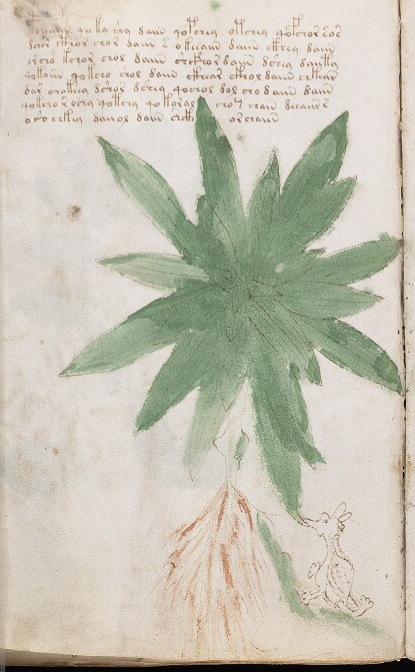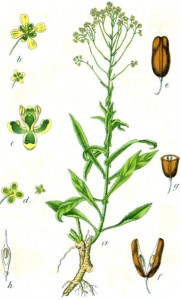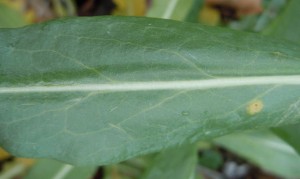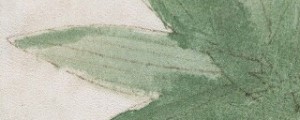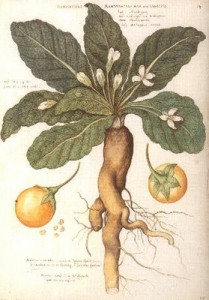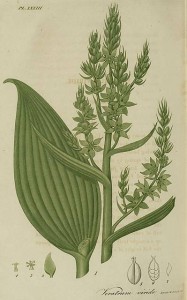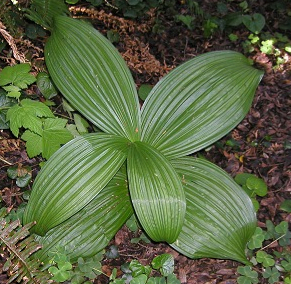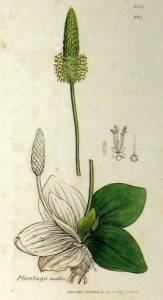Author Archives: J.K. Petersen
Large Plants – Folio 28v
Large Plants – Folio 28r
Large Plants – Folio 27v
Large Plants – Folio 27r
Large Plants – Folio 26v
Large Plants – Folio 26r
Voynich Large Plants – Folio 25v
With the exception of the tip of one leaf, most of Plant 25v inhabits the space below a block of text.
This is likely an aerial view of the plant, since it’s not often that plants show this shape and form of symmetry in a horizontal direction, although both possibilities should always be considered. To the bottom right is a creature that could be interpreted a number of ways. It might be a dragon or other critter nibbling on a leaf or it might be the proverbial dog pulling out a mandrake plant to save its master from harm.
The leaves are green and the roots somewhat harshly painted brown. Just as the blue scales/florets in Plant 32r look like they may have been colored with overly-dry pigment, the roots of 25v have a similar “scratchy” quality, as though pigment were applied with a course, inappropriate brush, or with left-over grainy or perhaps overly dry ink.
Perhaps the most important and significant feature of the drawing is that parallel veins are carefully indicated. Even if the paint is crudely applied, the illustrator took care to draw in the veins. The margins are also reasonably smooth.
Details
Leaves: The large elliptical leaves are drawn with distinctly parallel veins. The more recent ones are successively smaller than the older leaves nearer the stem.
Stem: It’s difficult to tell from the orientation of the drawing whether the whorl of leaves emanates from the ground or some distance up the stem. There is a short stem indicated above a knob that would be at some point on or near the ground. Whether the stem is in the picture to enable the illustrator to turn the plant 90° to show the leaf whorl or whether the plant has a short or medium-length stem, is difficult to determine from the picture alone. It’s likely that the stem is short or very short or probably it would have been drawn it longer, as in Folio 7r.
Roots: The roots are somewhat thick tendrils, numerous, and roughly painted a reddish-brown. They may also be deep, considering the illustrator ran off the bottom edge of the page.
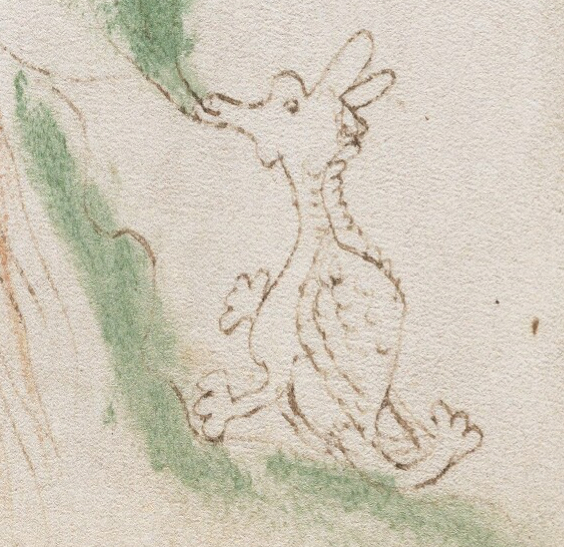 Animal: It’s tempting to see this as a scaly dragon, or cross between a dragon and a turtle, especially since we don’t know to what extent the VM author is teasing the reader with clues that are clarified by reading the text. It’s also possible it’s an oddly rendered symbolic dog, pulling out a mandrake plant, especially since the plant somewhat resembles the mandrake and the creature appears to have paws rather than claws or hoofs.
Animal: It’s tempting to see this as a scaly dragon, or cross between a dragon and a turtle, especially since we don’t know to what extent the VM author is teasing the reader with clues that are clarified by reading the text. It’s also possible it’s an oddly rendered symbolic dog, pulling out a mandrake plant, especially since the plant somewhat resembles the mandrake and the creature appears to have paws rather than claws or hoofs.
Looking at it again, however, it could also be seen as a sheep and the scalloped shapes that appear to be scales might be whorls of fuzzy wool. It’s difficult to tell if the lower limb is another leg or a fuzzy tail. If this is a sheep, it’s hard to explain the paws, since sheep have hooves. Perhaps a better understanding of the plant can reveal more about the enigmatic creature.
Prior Plant Identification
Edith Sherwood has identif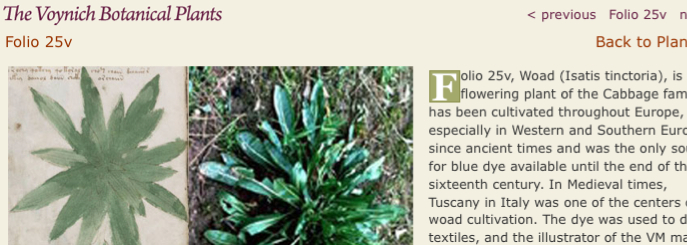 ied this as Isatis tinctoria (Woad), a common European dye plant mainly used for creating blues, sometimes in combination with other dyes. It also has some history as a medicinal plant.
ied this as Isatis tinctoria (Woad), a common European dye plant mainly used for creating blues, sometimes in combination with other dyes. It also has some history as a medicinal plant.
Here are some reasons why Isatis tinctoria may not be a good choice to represent Plant 25v:
- I. tinctoria initially has some leaves at the base, but it quickly puts up a stalk with alternate, clasping leaves, and a branched flower head. The VM illustrator readily added stems and flowers to most of the other drawings, so it strikes me as unlikely that important details for identification such as stalks and flowers would be omitted from the Plant 25v drawing.
- I. tinctoria typically has a large, main tap root, rather than a cluster of thick roots.
- I. tinctoria leaves tend to be more lanceolate (more slender at both ends) than Plant 25v.
- Significantly, I. tinctoria has a very distinct, whitish center vein, with the smaller veins radiating out from this central vein. I. tinctoria does not have parallel veins.
Thus, I. tinctoria differs from Plant 25v both in overall structure and details. There doesn’t appear to be much basis for identifying 25v as woad.
Other Possibilities
Convallaria, Polygonatum, Maianthemum and Disporum species have parallel veins, but a very different structure from 25v, with leaves growing in rows along a stem. Echinacea has long been listed as a medicinal plant in herbal literature, and it has a combination of parallel and radiating veins, but the leaves are narrower or smaller than 25v (depending on the species) and arranged in opposite pairs along the stalk. Cypripedium has erect, sparse leaves. Some of the lilies have parallel veins, but the leaves tend to be narrower, the bulbs are rounded, and a central stalk with a flower is almost always present. Trillium has parallel veins, and the leaves are often large, but as the name implies, the leaves are grouped in threes and the leaves are higher on the stalk than Plant 25v.
It would be well to consider plants with whorls of leaves closer to the ground that show the whorl shape for a while before they send out tall central stalks.
Mandragora, on the left has a thick man–like root, often with two or three “legs” and ruffled leaf margins. Veratrum, on the right, has smooth leaf margins, parallel veins and thinner roots, with more tendrils. Both have distinctive basal whorls.
The little critter with Plant 25v certainly suggests the possibility of a Mandragora (Mandrake) plant. It has large leaves near to the ground and a myth to go with the human-shaped root, but mandrake has thick knobby brownish roots somewhat shaped like parsnip. The leaf veins are not parallel and the margins are distinctly ruffled. Plant 25v appears to have relatively smooth leaves.
Plantago major and Plantago media (Plantain) have relatively large leaves in relation to their overall structure, parallel veins, and don’t always send up fruiting stalks early in the year. When growing in the open with a minimum of crowding from other plants, the leaves can sometimes be quite thick. Later in the year, there is a long narrow stalk with spiked blossoms. Plantain has a multitude of roots near the top but some species (e.g., Plantago media) have a tap root.
Like many of the plants mentioned, Plantago has long been listed as a medicinal plant in herbal literature. The shape of the leaves is similar to 25v except that the leaves become narrower toward the stem. Depending on the species, Plantain tends to be more cuneate or lanceolate than 25v but looking at it from the top, sometimes the overlapping leaves will hide this.
Veratrum viride (false Hellebore) has large overlapping leaves, a short stem, and parallel veins, but it also sends up a central stalk with smaller leaves and spiked green flowers. Veratrum album and Veratrum lobelianum have roots very similar to 25v, but the leaves tend to have longer stalks between the groups of leaves.
Left, detail of Veratrum fimbriatrum © Bob Rutemoeller. This is a rare California variety, so it is not specifically a candidate for 25v, but it shows Veratrum from the top. Veratrum nigrum is a Eurasian variety and has the same distinctive parallel veins and basal whorl. Clintonia borealis also has similar characteristics, although the leaves are not as deeply veined. Right, Plantago media botanical illustration, another plant with a basal whorl and parallel veins.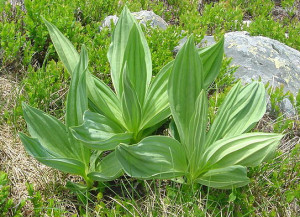 Gentiana purpurea or lutea (right, photo by Ghislaine) should perhaps be considered. Before it sends out distinctive tall, colorful stalks, G. lutea has a fairly thick basal whorl, parallel veins, and relatively smooth leaf margins (though it can also be ruffled, depending on the species).
Gentiana purpurea or lutea (right, photo by Ghislaine) should perhaps be considered. Before it sends out distinctive tall, colorful stalks, G. lutea has a fairly thick basal whorl, parallel veins, and relatively smooth leaf margins (though it can also be ruffled, depending on the species).
Summary
I don’t think woad or the mandrake plant are the best candidates for 25v, and I don’t think the critter at the base of the plant is enough to justify the plant as Mandragora, since it can mean many things, but the jury is still out as to which plant is the best choice.
The species of Gentiana that are most similar to the VMS drawing (e.g., G. lutea or G. purpurea) tend to have thick tap roots like dock or parsnip, so they don’t fit all the characteristics of Plant 25v. Veratrum nigrum, however, has a profusion of tendril-like roots, as do several of the Plantago species (e.g., P. major and P. lanceolata) but there isn’t enough detail in the drawing to determine whether Veratrum or Plantago might more closely match Plant 25v.
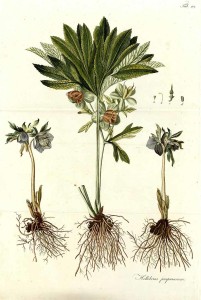
True hellebore (above) and false hellebore (Veratrum) both have distinctive whorls of leaves but those of Helleborum are not parallel like VMS Plant 25v.
If the leaves start a short way up the stem, as seems to be the case with the VMS plant, then Veratrum might be more the more likely candidate, since Plantago leaves tend to hug the ground.
Some species of Helleborum have a thick semi-whorl of leaves partway up the stem (see right), but the veins are not parallel. It is important to note, however, that the whorl of the VMS plant might be up the stem a ways, as there is a knobby stem showing under the whorl.
In some ways, the VMS plant incorporates characteristics of both hellebore (Helleborum) and false hellebore (Veratrum) but it’s probably a stretch to suggest complicated scenarios like combination plants. The Viola plant and several others are accurate enough that we can probably assume each drawing represents a single plant or, if there are two, that they can be distinguished from one another fairly easily.
Both Plantago and Veratrum (false hellebore) have enough characteristics in common with Plant 25v to be viable suggestions and both are commonly included in medieval herbal illustrations.
Posted by J. Petersen
Postscript, Feb. 2016: When I originally posted this plant ID in 2013, there was another plant I didn’t mention as an identification for Plant 25v because the leaf margins are serrated (almost spiny) rather than smooth. But maybe I should have, as it also has whorled leaves and parallel veins.
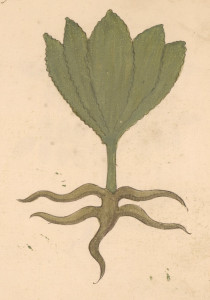 The pic on the right is from herbal manuscript LJS 419 and is labeled Salsificha, which we know as salsify or by the botanical name of Scorzonera. It is an edible plant grown as a commercial crop.
The pic on the right is from herbal manuscript LJS 419 and is labeled Salsificha, which we know as salsify or by the botanical name of Scorzonera. It is an edible plant grown as a commercial crop.
Note the partial stem between the roots and the leaf whorl similar to the way the VMS plant is drawn, and the bushy basal whorl (in this case, seen from the side). In life, the color of the root is dependent on the species, but at least one variety has reddish-brown roots and, like the VMS plant, salsify has parallel veins. Salsify is also known by names such as serpent root and viper’s grass, partly due to the long carrot-like shape of the root.
As the VMS illustrator was quite careful to distinguish between smooth and serrated leaf margins, I think the detail might matter in terms of trying to identify the VMS plants and that’s why I originally left it out of the line-up.
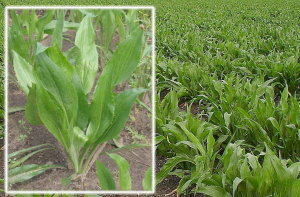 Here are some photographs from Wikipedia showing a detail of salsify leaves, alongside commercial crops of the plant that are grown as a food item. You can click on the image to see a bigger version.
Here are some photographs from Wikipedia showing a detail of salsify leaves, alongside commercial crops of the plant that are grown as a food item. You can click on the image to see a bigger version.
© Copyright 2013 and 2016 J.K. Petersen, All Rights Reserved

